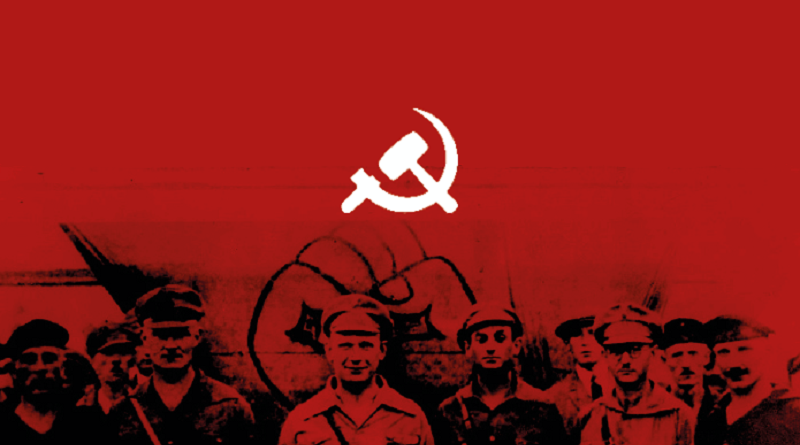Throwing Light : Observations on the role of communists in the antifascist movement
Without theory, structured organizations, and a guiding ideology practice is doomed to grope in the dark.
We must be resolutely done with groping in the dark. The world is moving fast around us and the concrete conditions produced by the decline of US imperialism and the rise of Trump have provided fertile ground for real fascism. Fascism is the far-right open terrorist dictatorship of the bourgeoisie in which all pretense of democracy has been abolished, and a fascist is anyone who ideologically supports or works towards these conditions in any capacity. To combat fascism most effectively in the present conditions we must break with several old ideas. This article is intended to generate discussion around that process or better yet to set it into motion.
Recently the Revolutionary Communist Party of Canada (PCR-RCP) released a short, useful article which exposes both the good and the bad of what is commonly called “Antifa”, read the article here: A Brief History and Assessment of Antifa Organizing
While there is no need to repeat the article, there is use in building on some of what this article is getting at. It begins by tracing some history of the first group called “Antifascist Action”, commonly abbreviated to Antifa. Antifa was called forth in 1932 by the Communist Party of Germany (KPD), at that time led by Ernst Thälmann, a committed Marxist-Leninist. In spite of its firmly proletarian and communist origins, Antifa today, in the US, is mostly associated with anarchists and their methods of organizing (some even go so far as to use the anticommunist iconography of three arrows in place of the original red flags logo).
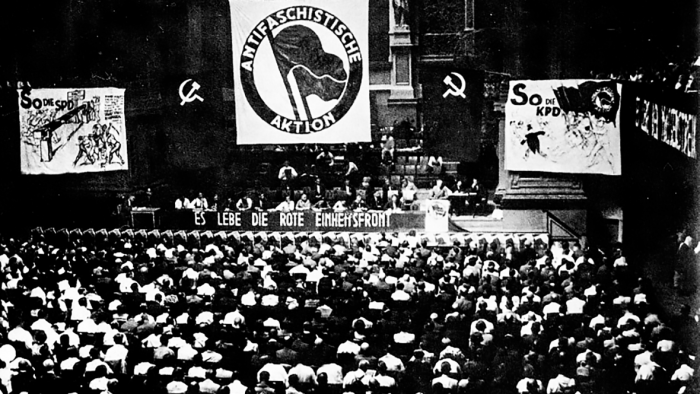
Since its beginning being crushed in 1933 by the Nazis, Antifa has now lost its party connections and has suffered greatly, becoming more a set of tactical decisions, general attitude, or orientation than an effective proletarian revolutionary organization. As the PCR-RCP point out, a low level of unity is all that is required for street fighting against Nazis in what amounts to an endless game of whack-a-mole. What is needed for defeating the fascists and preventing their conquering of state power is a higher level of organization (which necessarily requires a high level of unity); nothing short of a revolutionary vanguard, which can only be realized in the form of the Communist Party. The fact remains that the tactics employed by Antifa today can only bust up the lower level fascists and it cannot touch the ones already sitting in office. When it comes to street brawls and small scale property destruction no one can deny the anarchists their due respect. By the same token, when it comes to killing the fascists in their millions, that honor goes only to communists.
So what are the short comings of the dominance of anarchist tactics regarding anti-fascism? For starters anarchists in the imperialist centers tend to resist being defined; they refuse to admit any continuity unless it benefits their small project directly. This has resulted in a sort of default opportunism which essentially frames any self-critical assessment of the failures in our movement as “sectarian”, and no doubt a few will classify this article as sectarian too. Fascism is on the incline and if we do not honestly asses our failures in combating it then we have little hope of winning. Secondly anarchism promotes (when convenient) practice divorced from theoretical struggle, an over emphasis on action—“less talking more smashing”. This is a ploy to avoid addressing the first error and its volunteerism. Thirdly anarchism (in most manifestations) cannot establish the structures needed to support an ongoing revolutionary project, this condemns it to hop from movement to movement, or be a purely responsive ideology. It responds to fascist activity as “Antifa” but it does not sustain regular work which acts independently of the fascists’ activity. It gets things only half-right, half the time. All three of these types of errors have negatively affected and limited antifascist work. These errors are not exclusive to anarchism and are found among other sections of the left as well. Antifascism is only a starting point, being antifascist naturally means being pro-people and pro-working class. Antifascism is one front, albeit a critical one, it is not a single platform, and when taken as one it can only be reactive and not proactive.
There should be demarcations drawn between anarchism and liberalism but it must be understood that both have affected Antifa work negatively in the past. While anarchism is not liberalism, the latter being a bourgeois ideology, liberalism has certainly infected the former due to the inherent individualism of anarchism.
As Comrade Stalin pointed out: “We are not the kind of people who, when the word ‘anarchism’ is mentioned, turn away contemptuously and say with a supercilious wave of the hand: ‘Why waste time on that, it’s not worth talking about!’ We think that such cheap ‘criticism’ is undignified and useless.”
We must come to see Antifa and the anarchist influence within it as both good and bad at the same time. While this influence promotes a “leaderless” horizontal model it also rejects engaging in reformism. Failing to engage in reformism itself has a positive and negative aspect—it is great that anarchists reject the behavior of trots and social democrats and do not chase reforms, but if they do not build for revolution they are accomplishing as little as the reformists are. Nonetheless the appeal of anarchism is in the short term, the fact that it has, in contrast to most “communist” organizations, embodied the spirit of rebellion. If anyone is asked to choose between voting La Riva-Sawant-Moorhead etc. or smashing out a Starbucks-Gap-Bank of America window and hitting a Nazi with a bat then they should certainly not choose the voting option. In the context of what anarchists promote as a practical activity and what revisionists promote it is no wonder why anarchism has so much appeal among the youth, especially as an entry-level radical politics. It is for this reason that many Maoists in the US began in the traditions of anarchism—because they were looking for rebellion and through rebelling (practice) developed better ideas (theory) and became proletarian revolutionaries in that process.
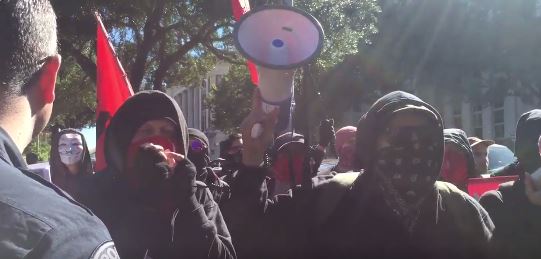
It should be clear that communists should continue doing antifascist work alongside anarchists and we should work together everywhere possible. What communists should not do is succumb to the phony “leaderlessness” prescribed by anarchists, which can develop with the help of liberalism into anti-communism. Communists must not tail behind in the antifascist movement; the people cannot afford for us to fail.
Communist organizing brings something different to antifascism, even on the small scale, by respecting the role of democracy in conjunction with centralism: dialectically understanding democracy and centralism as a unity of opposites. This understanding is not only more efficient, it offers far greater security and correctly insures the life of the collective above the expressions of the individual. This method of organizing collectives and cells offers a lot in terms of quick response and intelligence gathering.
Communist organizing, by rejecting bourgeois individualism, understands the role of the masses in antifascist work. This rejects the type of conspiratorial activity that sees the exceptional few making all the difference. It also correctly grasps the influence of bourgeois society on the masses and deals with how to bring the masses up ideologically to better break from the limitations of immediate self-interest. Communists rely on the masses while leading through them with methods like the mass line.
With stronger networks and firmer discipline focused on a comprehensive strategy to defeat fascism in the context of the simultaneous construction of the three indispensable weapons of Maoism (the Communist Party, the People’s Army, and the United Front), we will see a rise in controlled, militant antifascist organizing in the US. Within these three weapons anarchists are most certainly part of the United Front, but as with progressive sections of the petty bourgeois they should not be tailed behind and communist leadership should be won in every single battle. Because antifascism is itself a unity of opposites; while we unite with anarchists we must also struggle against them.
While it is correct to shut down and confront every attempt of fascists to publicly organize, it must not stop there and conditions must be taken into account. It is not acceptable for fascists to exist even if they hide underground and never march in public—they must be hunted down and weeded out. Their lives must become unbearable and even as individuals they should be hounded to the ends of the earth. Much of Antifa organizing has limited the focus to only confronting public displays of fascism and in the process allows them reprieve when they are not organizing.
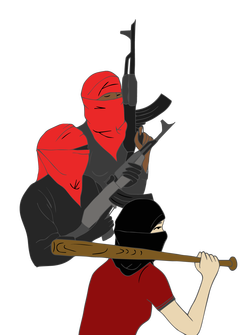
There is also an underdevelopment which shows itself in the US Antifa movement and we see this in the context of PR victories for the fascists. When the KKK or Traditionalist Workers Party stab people it is a victory for them—none of the fascists suffered the kind of wounds that the Antifa comrades suffered, despite the fact that the fascists were drastically outnumbered. This speaks to the fact that while our antifascist united fronts can call out numbers, the quality of our forces is still too low to decisively defeat even a small number of violent fascists. This could be due to many factors including a low level of unity, a low level of ideological development among the comrades on the ground, inexperience, or lack of resolve to risk prison and do violence. No matter the reason we must self-critically reflect and see where we can strengthen our local united front efforts against fascism. If the fascists go to knives or guns, we must be prepared to be the ones stabbing and shooting and avoiding being stabbed and shot. This means when antifascists outnumber fascists (like they did in both Sacramento and Anaheim) the initiative to fight them to the finish is not passed up.
Guerrilla tactics must be applied in antifascist work: when they outnumber us we should run away and when we outnumber them we should fuck them up—inflict more damage and more casualties on them than they can on us. According to Chairman Mao: “employ the tactics of avoiding strength and striking at weakness, of flitting about and having no fixed position, and of subduing the enemy according to circumstances, and when we do not oppose the enemy according to the ordinary rules of tactics, this is called employing guerrilla tactics.” He also explains, “if we really want to kill and exterminate the enemy there are weapons for us everywhere and work for us to be doing at all times in order for us to insure effective and united action…” “…for example, a kitchen knife, a wooden cudgel, an axe, a hoe, a wooden stool can all be used to kill people. Such actions as cutting electrical lines, destroying bridges, staring rumors, spreading poison or cutting off supplies can everywhere inconvenience the enemy or reduce his fighting strength.” While these examples given might not be desirable or immediately available to us in our present conditions, there is a universal truth in the creativity and conscious application of these tactics as principles. They should inform our orientation towards antifascist work.
Fascism should be attacked on all fronts; it should be hit culturally, economically, and physically. Artists and musicians must be called upon to create and promote antifascists works. Every bit of culture that intrinsically opposes fascism should be promoted and cherished. Culture itself is a battlefield and the fascist is well aware of this and uses subculture and counterculture to gain dejected recruits from vulnerable sections of the oppressor nation and even ideological compradors from the oppressed nations. Hard lines must be drawn against those who promote fascism culturally but who might not be fascists themselves—flirting with fascism should always come at a cost. Economically fascists should be targeted with acts of property destruction, sabotage of their jobs, and exposure to their community. Their funds must be discovered and cut off. If a business (for example, Blue Cat Café) has a noted financial connection to fascists then it should be targeted with boycotts and other activity which force it to close down. Physical confrontations must be consciously planned and care must be taken to avoid hitting the wrong targets. Self-defense must remain at the forefront of all antifascist activity.
In all of this we should keep in mind who our friends and who our enemies are, and we should not settle for inactivity or liberal solutions. There is always something you can do wherever you are to combat fascism. What Comrade Stalin expressed perfectly in 1924 holds true to this day, “In the present situation, ‘pacifism’ is the strengthening of fascism with its moderate, Social-Democratic wing pushed into the forefront.” While Stalin was speaking of the policy of some bourgeois governments in the post WWI period, we can understand this to mean that a passive stance should be struggled against in all fronts and the participation of the masses must be consciously sought. Understanding that the tactics of reformists, liberals, social democrats, and Trotskyists serve as a left-wing for fascism as they use redbaiting and other tricks to try and expose or discredit communist organizers and organizations. It has been seen in Austin multiple times that liberals will be fast to defend fascists physically while serving communists and anarchists up to the police.
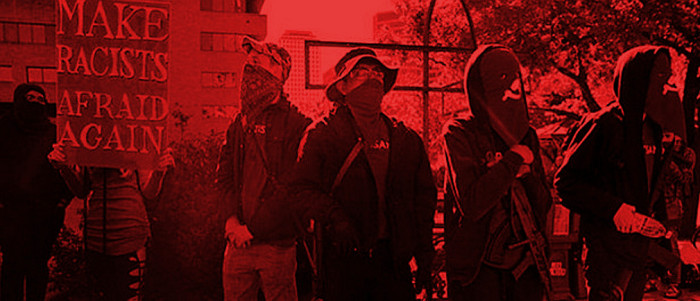
With better organizing and tactics antifascism will outmaneuver the enemy and organize among the broad masses of people real resistance to not only the run-of-the-mill white supremacists gangs and organizations but against the system itself which is now germinating fascism from its highest offices. Antifascism has already demanded a shift in tactics, from loose street fighting to organizing against ICE, the creation of safe houses, and other anti-state activity. This type of activity should be coming from revolutionaries who are the best fit to lead the masses. It is with revolutionary optimism that we throw light in dark times. The road is hard for sure but we proceed with militant energy and steadfast commitment.
Everything for the masses!
Red Guards Austin 2017
Source : https://redguardsaustin.wordpress.com/2017/03/04/throwing-light/

